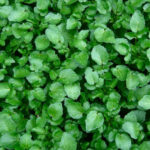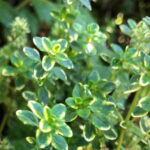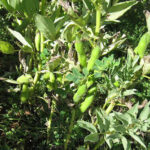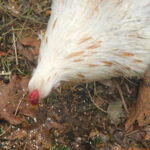Everyone knows what Spanish moss is. It’s that stuff that gently sways in the breeze as it drapes over the branches of an healthy tree in the South and Central America, right? But what really is Spanish moss? Is it actually Spanish? Is it actually a moss — or something else entirely?
Spanish moss is an epiphytic plant and a flowering plant. It lives on other plants rather than in soil. Unlike parasitic plants, Spanish moss does no harm to the oaks and cypress trees it calls home. Growing Spanish moss, therefore requires some form of tree-like growing medium.
Today we’re going to take an in-depth look at the most commonly-grown air plant in the United States and find out all about its history, growth habits, and a few common uses for its foliage.
The name “Spanish moss” actually originated as “Spanish beard”. Native American tribal people called it “itla-okla”, which meant “tree hair”. Some thought it resembled a conquistador’s long beard and began calling it “Barbe Espagnol”, or Spanish beard.
Over time, Spanish beard became Spanish moss, what it’s most commonly known as today. The Polynesians occasionally refer to Spanish moss as “Kali’s hair”, and throughout its natural environment it’s still called “hair”, simply because it resembles hair so much!
Spanish moss is native to North America, particularly from Texas to Virginia, where oak and cypress are both its host tree. In particular, its long tendrils hang from trees in moist environments. You’ll also find Spanish moss growing in Mexico, Central America, and South America. Spanish moss grows in regions with high humidity, and somewhat warm temperatures.
Spanish moss used to be used as cushioning material in car seats and mattresses the 1930s. It wasn’t until 1970 that commercial synthetic fibers were developed to mimic the properties of this interesting plant.
Listen to this post on the Epic Gardening Podcast
Subscribe to the Epic Gardening Podcast on iTunes
Spanish Moss Overview
| Common Name(s) | Spanish moss, Old Man’s Beard, Spanish Beard, Tree Hair, Kali’s Hair, French hair |
| Scientific Name | Tillandsia usneoides |
| Family | Bromeliaceae |
| Height and Spread | Can reach lengths of 20-25 feet |
| Light | Indirect lighting |
| Water | Regular watering preferred |
| Soil | Does not require soil |
| Fertilizer | Generally does not require fertilizer |
| Pests and Diseases | Can house pests, but is not typically fed on by pests, rot; birds build nests from its tendrils |
Types of Spanish Moss
One of the most notable things about Spanish moss is that it’s not even a moss at all — this Tillandsia is a bromeliad, and a relative of the pineapple. It’s also an epiphyte, which means it lacks normal roots and instead, Spanish moss grows on healthy trees and takes in its nutrition and moisture through its foliage.
T. usneoides ‘Munro’s Filiformis’, ‘Silver Ghost’, ‘El Finito’
This particular variety is native to Paraguay, but is commonly sold as ‘Silver Ghost’. It has fine and smooth tendril-like leaves which have a grey-green shade. It produces a greenish-tinged flower.
T. usneoides ‘Maurice’s Robusta’
Compared to the Silver Ghost variety, Maurice’s Robusta has far thicker leaves. It also tends to be a grey-green, but leans more towards the greyish side unless freshly watered. A native of Mexico, Maurice’s Robusta has become popular in Australia. It blooms yellow-green to yellow flowers.
T. usneoides ‘Odin’s Genuina’
Originally from Guatemala and Mexico, Odin’s Genuina is popular in Europe. It has fine silver leaves that range 4-6 centimeters in length. The flowers are more of a yellow-brown when it blooms.
T. usneoides ‘Spanish Gold’
Brilliant yellow tiny flowers and slender grey-green foliage are the highlights of Spanish Gold. With its origins in South America, it’s become widely cultivated elsewhere, and is quite popular throughout Australia and New Zealand.
T. usneoides ‘Tight and Curly’
This Spanish moss lives up to its name! Slender silver leaves that curl tightly together are its hallmark. This particular version is often grown in California flower gardens.
T. ‘Nezley’
This is an interesting hybrid form of Spanish moss. It’s theorized that it was cross-pollinated with Tillandsia mallemontii to produce a form of Spanish moss which bloomed light purple against silvery foliage.
T. ‘Kimberly’
Another hybrid of Spanish moss and “ball moss”, also known as Tillandsia recurvata. Silvery-green slender leaves form a dense clump that falls into the dwarf range of Tillandsias.
T. ‘Old Man’s Gold’
One more notable hybrid is Old Man’s Gold, a blend of T. usneoides with Tillandsia crocata. It’s known for its large yellowish flowers on silvery-green strands of foliage, but also tends more to the dwarf size rather than a more typical usneoides.
Caring For Spanish Moss
Overall, Spanish moss is easy to deal with. It grows wild all over the southeastern US, after all! There are a few things you can do to improve the longevity of your air-loving old man’s beard. Here’s a few recommendations.
Light and Temperature
Spanish moss likes indirect, but bright lighting most of the time. That’s why Spanish moss is so prevalent on a tree’s branches. There’s plenty of ambient light around, but it’s protected from the sun’s direct rays that dry it out quickly. Ideally, place your Spanish moss in a location where it can benefit from regular light, but won’t be hit by more sunlight than it needs from noon through late afternoon.
A little morning light won’t hurt it generally, but avoid too much direct sun, as it can cause the moss to turn black and to die off. Spanish moss plants survive in very warm, humid conditions with no issue. However, consistently cold temperatures below 22° Fahrenheit can damage the plant. If you live in USDA zones outside 7 through 11, consider growing Spanish moss indoors.
Water
Spanish moss likes water and humidity. It also doesn’t like to be wet for long, like most other bromeliads. Most recommendations are to water only when the plant is completely dry, and to give it a good soaking from the top when it needs it.
Indoors, place a bucket over your Spanish moss and pour cups full of water over the plant until it’s dripping. Outdoors, skip the bucket and just dampen your Spanish moss with a hose. Don’t water it again until it’s completely and totally dry.
You can occasionally mist it between the soakings if you feel it needs it. Use distilled water or rainwater to water your Spanish moss whenever possible. Too much chlorine is a major problem for this plant and may kill it.
Most varieties of Spanish moss acquire a greenish tinge when freshly watered, but they rapidly go back to a grey-green or silvery exterior as they dry out. Ideally, you want your Spanish moss to be mostly dry on the exterior within 20-30 minutes of being watered. Avoid overwatering it. Too much water can cause rot.
Soil
Spanish moss, like other epiphytic plants, doesn’t need soil. It prefers to grow on living healthy trees (specifically, tree limbs), although some people have successfully cultivated it using old oak or bald cypress tree’s branches – both are a host tree. Others have formed wire frames from which to hang their Spanish moss. However, it needs to hang straight down from whatever it’s resting on. It does not do well if it bundles up into a mass!
What Spanish moss prefers to soil is good airflow. It needs to be able to sway in the breeze. Most trees will suffice in the right conditions. Large trees give Spanish moss more room to grow.
While it’s not clear exactly what it is about oak and cypress that makes them perfect environments, it’s assumed it has to do with the lack of resinous sap and with their shady canopies. Both live oaks and cypress trees produce large amounts of shade, which makes them perfect for Spanish moss.
Fertilizer
Cultivators of Spanish moss are split on whether it’s good to fertilize it or not. If you do decide to fertilize yours, use a super-diluted form of an orchid or bromeliad fertilizer. Often, it doesn’t need fertilizer at all.
If you have any question as to the strength of a fertilizer for Spanish moss, it might be wise to start another couple of cuttings and get them established so that you can test out fertilizers on them. With this plant, less is more – if you are at all in doubt, don’t fertilize your plant.
Propagation
Like most other bromeliads, Spanish moss is often cultivated by offshoots. It can grow to reach lengths of nearly 20 feet, and typically side shoots are cut to start a new plant, rather than from the main stem. You can trim off one of the side shoots of your Spanish moss and start treating it as if it were a new plant. Most of the time it will flourish on its own.
You can actually grow Spanish moss from seed as well. However, to harvest seed from Spanish moss, you have to be there at exactly the right time. It is fluffy and easily carried away on the wind like dandelion seeds, which means that the very few seeds each flower produces are whisked away. It’s far easier to start a Spanish moss plant from an existing offshoot.
If you are starting a new Spanish moss cutting, prepare what it’s going to hang from first. Are you going to use a wire frame, an old tree branch, or something else? After you prepare, drape your Spanish moss cutting overtop and water it. Water again once it’s completely dry to encourage further growth.
Pruning
You can trim Spanish moss to length simply by snipping off the ends, but avoid doing that often as it tends to cause more side shoots to form. It’s a slow grower, but it does grow and it does spread over time.
Troubleshooting Spanish Moss Issues
Interestingly enough, Spanish moss does not appear to have any natural predators. However, it frequently houses all manner of wildlife. You probably won’t have many problems, but let’s discuss a few that can arise.
Growing Problems
We’ve touched on a few of the issues that occur when caring for Spanish moss. Your plant may experience symptoms from either under or overwatering. Browning dry tips may indicate underwatering or a lack of humidity. Provide more water or humidity for a dry Spanish moss plant.
The inverse is also possible. Spanish moss plants need to dry completely between waterings. Therefore, if the foliage becomes brown and mushy, cut back on watering. When you do water again, shake off any excess to prevent rot.
Spanish Moss Pests
There is a spider species, Pelegrina tillandsia Kaston that lives in Spanish moss, but it is harmless to humans. Other pests that make their home in Spanish moss include chiggers, spider mites, some species of butterfly, and boll weevils. In the home, you can use a typical insecticidal or miticidal spray or organic alternative to keep pests out of your Spanish moss.
Once Spanish moss has died and fallen to the ground, frogs make homes in it. Birds also harvest Spanish moss as nesting material, both living and dead, so if you’re starting a batch of moss outside, you may want to protect it from bird-theft until it’s grown enough to handle it. Some species of bat may also use Spanish moss for daytime shelter.
It’s also a very disease-free plant on the whole, only being susceptible to rot if it’s left in a large quantity of water for too long. Since it generally hangs to grow, this is unlikely unless the plant has fallen off of its perch somehow.
Frequently Asked Questions
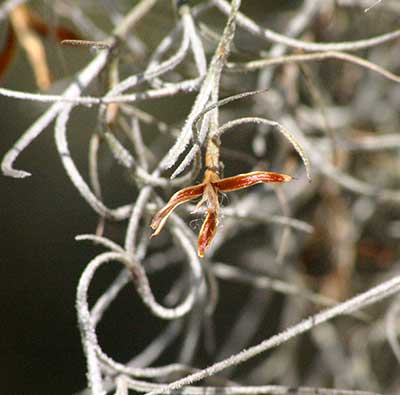
Q: What has Spanish moss been used for?
A: Over time, Spanish moss has been used for clothing, as padding in pillows and mattresses, and even as part of swamp coolers. It has no nutritious value, so it’s not commonly used as livestock fodder. It’s also a favorite in dried floral arrangements or as part of craft projects because of its unique look.
Q: Does Spanish moss feed on my trees or other plants?
A: Actually, no. Spanish moss has no roots that go into the tree’s surface, nor anything which could poison the tree it’s hanging on. However, as it grows, it can start shading lower leaves or tree branches by accident and can lower the tree’s ability to photosynthesize light. For this reason, it’s recommended to thin out the Spanish moss on your trees occasionally when it starts to form very thick, light-blocking mats.
Q: Is Spanish moss poisonous to my pets?
A: Nope! It’s safe around your pets. However, if you have pet birds who have free range in your house, your Spanish moss may end up worked into their nest if you aren’t attentive.
Q: How do you keep Spanish moss alive indoors?
A: Try to simulate the same conditions a Spanish moss plant needs outdoors indoors, and you’re set. See the care section above! Grow Spanish moss on tree branches and allow them to dry out between watering.
Q: Is Spanish moss OK to touch?
A: Indoors, touching Spanish moss should be no problem. Outdoors, you might want to avoid touching. Spanish moss hosts various spiders, mites, and other insects. Chiggers, specifically enjoy biting humans, and leave behind toxins that can irritate skin.
Q: How long does Spanish moss last?
A: Beyond knowing that a Spanish moss plant will survive dry periods for a month or two, this is a hard question to answer. Spanish moss plants are resilient, and can live many, many years.
Q: How often should I water Spanish moss?
A: When you grow Spanish moss, water it when it dries out completely. In most areas, this watering should occur every week in spring and summer, and every other week in fall and winter.
Q: What does Spanish moss eat?
A: Spanish moss lives by consuming nutrients, water, and oxygen from the air. It can also feed on light fertilizers. In the wild, it relies on conditions in the healthy tree it lives in to thrive.


